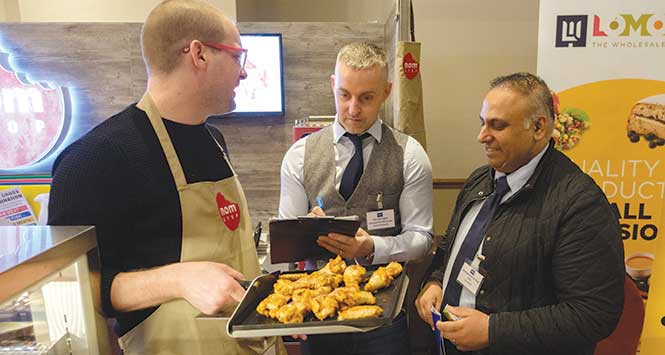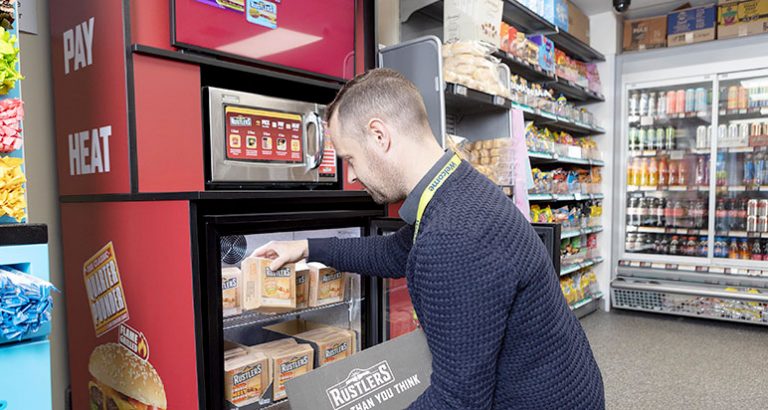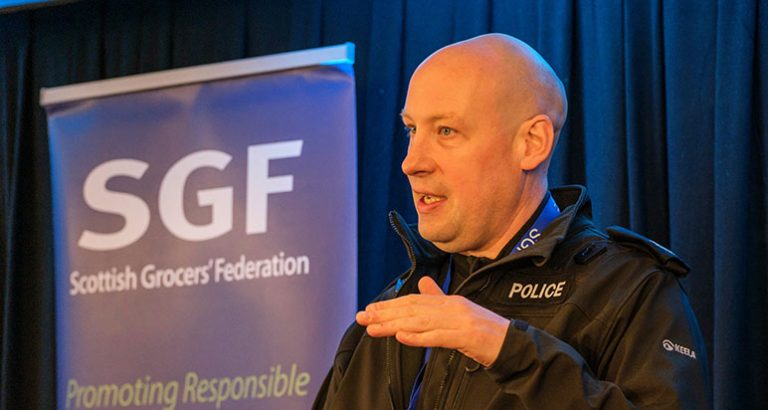Free samples aside, there was plenty for retailers to get their teeth into at the latest SGF mini-summit where food-to-go, free-from, fresh and news were all on the menu.
by Findlay Stein
It was pretty much a full house in Falkirk’s Macdonald Inchyra Hotel for the Scottish Grocers’ Federation’s recent mini-summit (30 April), where an audience of retailers, suppliers and other industry figures listened to seminars on free-from, fresh and the importance of the news category.
SGF Chief Executive Pete Cheema kicked proceedings off with a bang by announcing a £300,000 extension to the Scottish Government’s Food-to-go grant scheme. Retailers can apply for grants of up to £7,500 in matched funding to develop the food-to-go offer in their stores. A total of £250,000 was distributed under the scheme in 2018, which will again be administered by SGF. Successful applicants must show a commitment to local sourcing and to offering a range of healthy eating options.
Twin challenges
Cheema was followed by Martyn Parkinson, Booker’s Brand Director for Premier and Family Shopper, who gave advice to retailers thinking about making a go of food-to-go.
Referencing SLR’s April cover story ‘Is 30% the new 20%?’, Parkinson said retailers had to embrace the category to fight off the twin challenges of declining footfall and increasing costs. Tapping into a market worth £21bn wasn’t difficult, he said, “but you have to do a really good job” to capture the customers who visit a c-store to buy a newspaper and cigarettes then go to McDonald’s or Greggs to spend £5 on a high-margin breakfast.
Parkinson’s straightforward advice was to start with bean-to-cup coffee (price-checked against the likes of nearby Greggs and McDonald’s) before building on that foundation with a good sandwich meal deals.
This is exactly what Premier’s Victoria Dock ‘store of the future’ in Hull did, said Parkinson. The store sits in the middle of a housing estate with no passing traffic but is shifting 600 cups of coffee per week and 75 sandwich meal deals a day.
More than a coffee machine
The food-to-go theme was extended by Craig Duncan, Head of Business Development Scotland and Northern England for Costcutter. Duncan acknowledged that food-to-go is not equally relevant to all retailers. While there are huge wins to be had, this was perhaps easier for a city centre store with high footfall, he said. There were clear opportunities, however, for suburban and rural stores who get the offer right.
“Food-to-go is about more than having the right brand of coffee machine in store,” said Duncan. “It’s about knowing your customers well, what they want and what they’re going to buy into.”
He shared the example of KB Stores in St. Andrews where Costcutter retailer Anila Anwar was frustrated that food-to-go shoppers were leaving empty-handed. The store is under 1,500sq ft and had a lot of space given over to grocery over its four aisles. Anila ripped out a central aisle to create a big food-to-go space full of simple solutions, resulting in a five-fold increase in food-to-go sales.
Duncan then showcased Stuart Mitchell’s store in Newburgh, Aberdeenshire. Stuart was one of the first retailers to take advantage of the food-to-go grant, practically doubling the size of his offer. He supports local producers and uses bespoke labels to build confidence and trust. He also offers a range of healthier options easily produced in-store, like small tubs of grapes and mixed fruit packs.
In conclusion Duncan said retailers “had to invest to progress,” urging them to make the most of the funding available.
The next bottled water
The shift towards healthier options in the snacking market was discussed by Ken Cameron, Account Controller for Nairn’s Oatcakes, as he launched the seminar on free-from. Comparing the category to bottled water, which grew from a niche product to “multiple facings in every half-decent chiller”, Cameron predicted free-from will be worth £1bn by 2023. He flagged gluten-free and sugar reduction as the two main trends in healthy snacking currently.
His advice to retailers was to make space for a range of healthy snacks alongside the more traditional impulse offerings, but not to expect similar rates of sales to crisps and Mars Bars.
Cardboard no more
Picking up on Cameron’s theme, Victoria Sowerby, Ecommerce Manager for Quorn Foods, then talked about the changing attitudes of shoppers towards food. She said vegetarianism and veganism used to mean “tasteless vegetable nuggets” or “cardboard burgers” but now present a real opportunity, perhaps best witnessed by the runaway success of the Greggs vegan sausage roll. It’s notable that two of the day’s other speakers also mentioned this marketing phenomenon, and the whirlwind of publicity and social media activity that accompanied its launch.
Meat-free is one of the fastest-growing categories in both value and volume in an otherwise stagnant grocery sector, she said, as more shoppers start to understand the impact of meat on the environment as well as its health implications. With 14% of the UK’s population describing themselves as ‘flexitarian’, Sowerby said it was important to provide solutions for these shoppers, given that almost one-third (29%) of all evening meals now don’t contain meat.
Quoting David Attenborough, who said mankind must stop eating meat for the good of the planet, she said Quorn thinks meat will be “the next big thing” to grab the public’s attention after single-use plastic.
So why should retailers embrace meat-free? With grocery struggling, Sowerby said meat-free can drive growth and provide an incremental opportunity. Meat-free shoppers are “very loyal”, she said, and will return to your store if they can find the products they’re looking for. They also spend four times more in store buying other items to build meal solutions, she concluded.
The new consumer
The free-from seminar was concluded by Costcutter’s Craig Duncan who returned to the stage to urge retailers to be aware of the new consumer emerging, and how their attitudes and decisions were starting to shape the market.
Duncan went into some depth profiling the new generation of “mindful” consumers that retailers should target, warning that free-from was still a category “on the fringes” of many retailers’ offer and thinking.
Duncan then shared the learnings from Costcutter retailer Allan McCorquodale’s store in Eskbank, a “reasonably affluent” suburb of Edinburgh with “switched-on” shoppers very attuned to the benefits that free-from can bring. Acting on this, Allan has created a buzz around free-from in his store.
He offers a variety of products at different price points to cater for shopper needs. Allan stocks several Alpro SKUs and the dairy-free milk’s popularity with customers led to the introduction of Violife dairy-free cheese. He is also seeing growing demand for gluten- and alcohol-free wine and beer.
It’s worth noting that Allan merchandises free-from products in the relevant category, rather than lumping them all together in a dedicated free-from aisle. This, Duncan said, made it much easier for ordinary shoppers to recognise that alternatives were available to facilitate the switch into healthier products. It also meant that customers with health-related dietary requirements didn’t feel confined to a single area of the store.
Fresh focus
The day’s second seminar focused on fresh. It kicked-off with Costcutter’s Mike Owen, Category Director, Fresh Frozen and Direct to Store, discussing what a great fresh offer enables retailers to do.
Fresh, he stated, “pulls customers through the door” and “absolutely drives footfall”. One of the biggest product areas on which a store is judged, Owen said a good offer will drive a retailer’s brand credentials.
Not only will fresh and food-to-go help boost sales, they also – with their higher margins than ambient products – will help push GP towards that much-discussed and all-important 30%, he added.
Owen told the audience that it was fundamental to understand what shoppers want, especially the ones who aren’t coming in, and create the range they need.
He said shoppers were time hungry and want value-for-money meal solutions that are quick and easy to prepare, highlighting the importance of having not just an evening meal deal, but a range of timed solutions throughout the day.
Addressing the issue of profitable waste, Owen said “you have to invest in some waste to get new shoppers in the door”. It is vital to keep shelves fully stocked because, as he pointed out, if something’s there one day and not the next then customers won’t come back. He said waste was an investment that grows sales in the long term.
Healthy Living shake-up
The SGF’s Healthy Living Programme (HLP) has been promoting fresh food since its inception and it seems the public are increasingly getting the message. The Programme’s Director, Kathryn Neil, told the audience more than one-third of people are eating healthier than a year ago and half of consumers are looking to consume more vegetables in the next 12 months.
To keep up with these trends Neil said the HLP needs to make it easier for retailers to sell a wide range of healthy products. To facilitate this, she heralded changes across five areas: staff, branding, POS, display equipment and social media.
Announcing the promotion of Gillian Edgar to Field Manager and the appointment of two new Development Managers, Neil unveiled a new HLP logo that focuses more on health rather than just fruit and veg and has the new strapline “Love life. Eat well.” The rebrand also includes a new stripped-down range of POS material and a new-look HLP display stand, which can now accommodate not only fresh fruit and veg but also other healthier products. This, Neil said, allows the space to work harder for retailers.
The new stand is similar in height and width to the current model but has double the capacity. It will be introduced gradually in the near future but, due to financial constraints, existing stands won’t be swapped out.
Neil concluded by launching a Facebook page for the Programme, to be found at facebook.com/healthylivingprogramme.
Retailer’s view
Day Today Elite store owner Mohammed Rajak, Owner of the Day Today BuyWell Store wrapped up the session with a retailer’s perspective on both fresh and food-to-go.
Mohammed’s store in Glasgow’s east end sits in an area of fierce competition provided by 70 other nearby retail units. It is close to a main road and a railway station and commuters are Mohammed’s “bread and butter”. Like Owen before him, Mohammed said fresh produce was a barometer of how well a store was doing and how dedicated you were to retailing.
He stressed the importance of using local suppliers when sourcing fresh produce. You must also target the right audience and have a unique selling point, he said, to keep customers coming back “day after day”.
Before he got serious about fresh, Mohammed admitted he was one of the retailers Owen referred to “who wanted 0% waste”. He took the advice of Day Today, who told him he needed to have profitable waste to offer the right range and choice for customers. “It will also help you make the leap to 30%.”
Mohammed worked with United Wholesale’s merchandising team and the SGF to get his fresh range right, and it now accounts for up to 40% of his grocery revenues. In his experience, meal deals, a home baking range and fresh flowers and plants are all good footfall drivers.
Mohammed concluded by urging retailers to embrace the SGF’s Healthy Living Programme. He said they were “a great team to work with” that had had an amazing impact on his store.
What’s new in news?
The mini-summit was wrapped up with a seminar on the ‘Importance of News’. The Times Scotland Editor Magnus Llewellin, despite his PowerPoint presentation going AWOL, gave a fascinating insight into a day in the life of a national newspaper editor.
Parent company News Scotland had invested heavily in The Times, he said, to help maintain share in an increasingly competitive market where buying a newspaper is now a considered purchase. “The days of people buying two or three papers a day are well and truly gone,” he said, a fact that local retailers are only too well aware of.
Looking to the future, he said the focus was on to continue growing the Times as a brand as it was in the interests of everyone that the indigenous newspaper market continues to thrive. In conclusion he said that the network provided by local retailers was “vital” to the future of the industry.
Llewellin’s colleague, the News UK Retail Sales Director Neil Spencer, then acknowledged the challenges faced by the news industry. People are consuming more news but differently, he said, adding that more people now viewed news online than looked at Facebook.
With a value of £1.8bn, £700m more than bottled water, Spencer said news was still a vital category that “brings people into your store”. He said it was an asset that had to be worked harder to get as much value for retailers as possible.
To that end he highlighted the Sun Savers scheme, “the most valuable rewards scheme in the UK of any brand,” as a particular footfall driver and mentioned the Times subscription programme, which can earn retailers up to £40 per conversion.
He also showcased the company’s React scheme, which allows food and drink brands access to in-store activation to generate cross-category sales, and MyStore+, a new app that gives convenience retailers access to category and brand advice, offers and rewards.
The mini-summit, chaired by industry veteran and convenience retail consultant Mike Gordon, also included a bustling trade show which hosted somewhere in the region of 25 exhibitors.







